|
|
Welcome to the Winter issue of the LIFE Dee River newsletter!
Our progress to date...
- 10,590 trees planted
- 5,500 tonnes of gravel, boulders and woody material introduced into the river
- 29km of riverside fencing completed
- 11 forest drain culverts upgraded
- 6 barriers removed or adapted
- 1 new forestry river crossing installed
|
|
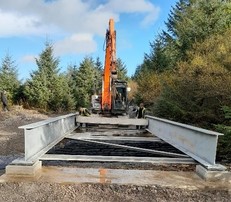
Over the last few months, we have constructed a new bridge for forestry machinery over a ford within the Penaran forestry block, in the upper catchment. Watch a timelapse video of the build here.
Prior to the construction of the bridge, the only way to cross the river was to drive directly through the river over the existing ford. The structure will stop an estimated 2,000 passes of 44 tonne articulated lorries having to directly drive through the watercourse during harvesting and transportation. Over the next 5 years it is estimated that approximately 25,000 tonnes of timber will be harvested and transported across this route.
The bridge will help limit the input of sediments and nutrients from entering the watercourse and will also reduce the chances of any further contaminates from entering the Dee.
Emerging science has demonstrated that compounds in tyres are having a lethal impact on Coho salmon. Whilst the LIFE Dee River project focuses on Atlantic salmon, we don’t yet know if these impacts will affect all salmon species (and other organisms). Therefore, removing the potential risk by building this bridge will have multiple benefits. Read the study here.
|
|
|
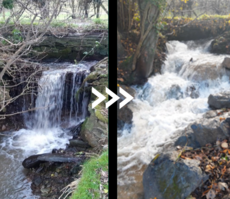
Nant Gwryd, a tributary of the River Ceiriog, south of Pontfadog in the Ceiriog valley has historically been an important fish spawning tributary for sea trout and salmon. However, road improvements some years ago and the placing of gabions into the channel of the adjacent tributary resulted in erosion of a 6ft vertical drop and an incised channel, making it impassable to fish moving upstream. Thick vegetation obscures the drop for much of the year so it was not immediately obvious as a problem. Electrofishing surveys carried out in summer 2022 showed no salmonids upstream of this structure, confirming it was an impassable artificial barrier to migratory salmonids.
Following discussions and excellent cooperation from the local farmer, and approval of an Ordinary Water Course Consent through Wrexham Council, work commenced to construct a rock ramp fish easement using different sized boulders and gravels, and stock fencing to keep livestock away from the edge. The resulting stepped ramp will allow fish to move up and is a significant improvement to the previous situation. This structure was not one of the project’s original target barriers, however we decided it would be highly beneficial to the environment to make improvements here. We will monitor the site with electrofishing surveys in the summer, and observation of any spawning beds (redds) is ongoing to see if fish passage has resumed.
|
|
|
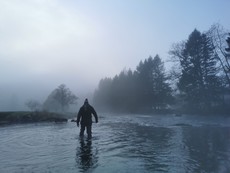
During late November and December, members of the team were out across the Dee catchment counting salmon redds. We carry out this work to assess the impact of our in-river works, such as gravel introduction, on salmon numbers. Whilst we are out we also see sea trout redds, and it gives us an opportunity to look out for other issues that we can address through the project.
Pleasingly, redds were observed on the gravels we introduced to the Afon Tryweryn, Alwen and Brenig. We also saw redds at the Aerfen site on the main river where we recently introduced boulders back into the river. Electrofishing surveys in summer 2023 will provide more information on juvenile fish numbers in these areas, providing further evidence of the benefits of the work.
When salmon spawn, the females use their tail to create a depression in the river bed into which they lay their eggs before moving slightly upstream and covering the eggs with gravel, this is called a redd. Salmon frequently cut more than one redd, and can lay between 1200 – 1500 eggs per kilo of body weight!
|
|
|
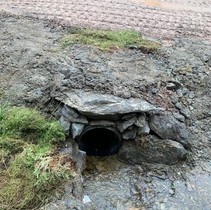
As part of our efforts to improve water management at the forestry, we recently carried out work on 11 culverts along 5 miles of forestry track at the Aberhirnant and Llangower forestry block. Culverts are enclosed watercourses, such as large pipes, used to divert or drain water from land above it. Having surveyed the entire forestry block, we replaced 8 existing culverts which were in poor condition and installed an additional 3 new culverts to different sites along the forestry track. Improving these culverts will significantly reduce the amount of sediment and other contaminates from the track from being carried into nearby watercourses in the catchment, especially during flash flooding.
Sediment traps were installed along the culverts as a simple method of catching sediment. The traps involve excavating a hole above or below a culvert to interrupt the flow of the water, this allows particles to settle whilst still allowing water to pass through the outflow, leaving sediment behind in the trap.
Diverted water from the traps will also create wet flushes and sumps for the excess water. These flush areas will be managed in future forest resource plans for the removal of conifer trees that will not thrive in the wetter areas and allow deciduous native species of willow and alder to populate.
|
|
|
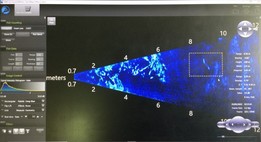
As part of the monitoring component of the LIFE project, we are trying to collect information on the ecology and biology of our SAC species in the Dee. This includes both migratory lamprey species - sea lamprey (Petromyzon marinus) and river lamprey (Lampetra fluviatilis). Just like salmon, they leave the river in the juvenile life stage heading to sea to grow. They then return as adults to spawn in the gravels of the river.
To effectively manage these populations, it is important to collect data on the time of year that they enter the river, how they migrate upstream, how far they travel, any barriers to migration, and establish the key areas where they spawn. Having an idea of population size is also highly relevant, so we have begun an intensive trapping programme to capture adult lamprey and we use this data in conjunction with visual counts.
In the lower Dee, we have deployed an underwater sonar camera (Adaptive Resolution Imaging Sonar or ARIS) which uses sound rather than sight, to collect data on migration into the river. This sophisticated piece of equipment scans out 96 beams of sounds horizontally into the water column and the sound bounces back from whatever it hits, allowing the ‘brain’ of the ARIS kit to transform this into an overhead image of what is moving though the water. This is deployed in the hours of darkness or in coloured water when nearly all lamprey migrate. The imagery can then be viewed back in the office to count and measure the fish.
In early 2022, we successfully observed river lamprey migrating into freshwater for the first time (ARIS experts weren’t sure if this equipment could see such slender fish), and the recordings from summer 2022 are currently being analysed to obtain a baseline run size for adult sea lamprey.
|
|
|
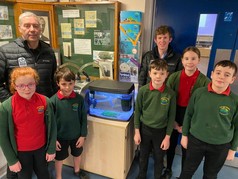
Have you ever thought what changes happen as fish eggs develop from tiny eggs into fry, and then into fish? Our popular classroom hatchery project is back once again with Eryri National Park Authority. The Wardens based at Llyn Tegid have set up a temporary trout hatchery at Ysgol O M Edwards in Llanuwchllyn, in the upper catchment. By establishing the hatchery and caring for the fish eggs, pupils will learn about river ecology and the life cycle of trout by overseeing their development from fertilized eggs to small fry in a special fish tank.
As well as the school hatchery, the Wardens will oversee another hatchery at their centre on the shore of Llyn Tegid. From there they will monitor the condition of the eggs and prepare video diaries at key stages in their development. They’ve also set up a 24/7 live stream from the tank so you can tune in and watch the fish hatch in real time! A comprehensive education pack full of activities is also available on the hatchery project’s webpage, so schools all over the country can benefit from this fantastic project.
After hatching, the fry will remain in the hatchery until they have grown large enough to survive in the Afon Twrch, a tributary of the River Dee. Although around 100 eggs will be placed in each tank, unfortunately not all are expected to survive as some eggs will naturally fail, and some fish will be subject to disease testing before the remainder can be released into the river in order to protect the native wild stock of brown trout.
Watch TV coverage of the hatchery project on S4C's Newyddion here.
|
|
|
|
On farm interventions
Over the next couple of months, work will be carried out on a number of farms across the catchment to reduce the amount of nutrients entering local watercourses, and ultimately the Dee SAC (Special Area of Conservation). This is additional work by the project team to offer extra benefits in areas where we have carried out other work, such as fencing, through the project.
Chester weir
Ongoing design work is being carried out by an external contractor to design the fish passage solution to be installed at Chester weir. The main issue at this site is delay to the downstream movement of smolts, the proposed solution will alleviate this issue and reduce delay at the structure.
PhD student
We are lucky to be able to offer an opportunity to an existing PhD student to work with the project for 3 months to assist with some of the monitoring elements of the project. This will benefit the project as we will be able to delve in more detail into some of the results we are seeing, and will also benefit the student as it will give them an opportunity to gain valuable practical experience.
|
|
|
|
|